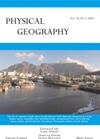Novel insights for streamflow forecasting based on deep learning models combined the evolutionary optimization algorithm
IF 1.4
4区 地球科学
Q4 ENVIRONMENTAL SCIENCES
引用次数: 6
Abstract
ABSTRACT Various hybrid approaches combined the different deep learning and machine learning models with evolutionary optimization algorithms and have improved the accuracy of streamflow forecasting problem. In this article, three deep learning models were investigated for streamflow forecasting with various lag times at both stations (i.e. Sidi Aich and Ponteba Defluent), Algeria. Also, a machine learning [i.e. feedforward neural network (FFNN)] model was implemented to compare the forecasting accuracy of deep learning models. The particle swarm optimization algorithm was combined to determine the hyperparameters (i.e. model structure) automatically based on adaptive moment estimation algorithm. The addressed two-stage hybrid models were assessed and evaluated by root mean square error (RMSE), signal-to-noise ratio (SNR), and Nash–Sutcliffe efficiency (NSE) statistical indices. Evaluating all models explained that the GRU II two-stage hybrid model (RMSE = 35.241 m3/s, SNR = 0.5159, and NSE = 0.7337 at Sidi Aich and RMSE = 11.074 m3/s, SNR = 0.3600, and NSE = 0.8703 at Ponteba Defluent) was found to produce more accurate results compared to the Elman recurrent neural network, long short-term memory, and FFNN two-stage hybrid models during testing phase for forecasting streamflow.基于深度学习模型结合进化优化算法的流量预测新见解
各种混合方法将不同的深度学习和机器学习模型与进化优化算法相结合,提高了流量预测问题的准确性。在本文中,研究了阿尔及利亚两个站点(即Sidi Aich和Ponteba Defluent)的三个深度学习模型,用于不同滞后时间的流量预测。此外,还实现了机器学习[即前馈神经网络(FFNN)]模型,以比较深度学习模型的预测精度。在自适应矩估计算法的基础上,结合粒子群优化算法自动确定超参数(即模型结构)。通过均方根误差(RMSE)、信噪比(SNR)和Nash–Sutcliffe效率(NSE)统计指数对所处理的两阶段混合模型进行评估。评估所有模型解释说,与Elman递归神经网络、长短期记忆、,以及在测试阶段用于预测流量的FFNN两阶段混合模型。
本文章由计算机程序翻译,如有差异,请以英文原文为准。
求助全文
约1分钟内获得全文
求助全文
来源期刊

Physical Geography
地学-地球科学综合
CiteScore
3.60
自引率
0.00%
发文量
18
审稿时长
6 months
期刊介绍:
Physical Geography disseminates significant research in the environmental sciences, including research that integrates environmental processes and human activities. It publishes original papers devoted to research in climatology, geomorphology, hydrology, biogeography, soil science, human-environment interactions, and research methods in physical geography, and welcomes original contributions on topics at the intersection of two or more of these categories.
 求助内容:
求助内容: 应助结果提醒方式:
应助结果提醒方式:


